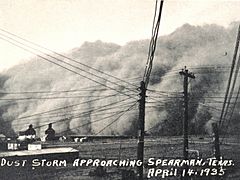Soil erosion facts for kids
Soil erosion is the washing or blowing away (by water or wind) of the top layer of soil (dirt). This is a serious problem for farmers. If the soil has eroded, the crops will not grow very well.
Soil erosion was a big problem in the Midwestern United States in the 1930s dust bowl.
Erosion also leaves large sinkholes in the ground, which can weaken buildings and even cause them to collapse. Urban areas are usually protected from soil erosion, so not many buildings collapse from erosion.
Steps for conserving soil from eroding
Soil erosion can be conserved in several ways:
- A wind break is a line of plants that are planted to stop or slow the wind. A thick row of bushes or shrubs planted next to a field of crops can stop the wind from blowing the soil away. This method also helps against water erosion, as the soil gets caught up against the roots of the bushes, rather than washing away.
- Terraces are level places that have been made on hill sides. They are used for Terrace farming.
- If the crops are growing on a slope, then one should plant them in contour lines that run across the slope, rather than up and down. So, if the slope goes downhill to the south, then the plants should be in rows that run from east to west.
- Groynes (wooden planks) along the beaches can resist erosion, or sea walls against cliffs can protect the cliffs.
Images for kids
-
An actively eroding rill on an intensively-farmed field in eastern Germany
-
Soil and water being splashed by the impact of a single raindrop.
-
A spoil tip covered in rills and gullies due to erosion processes caused by rainfall: Rummu, Estonia
-
Dobbingstone Burn, Scotland—This photo illustrates two different types of erosion affecting the same place. Valley erosion is occurring due to the flow of the stream, and the boulders and stones (and much of the soil) that are lying on the edges are glacial till that was left behind as ice age glaciers flowed over the terrain.
-
During the 17th and 18th centuries, Easter Island experienced severe erosion due to deforestation and unsustainable agricultural practices. The resulting loss of topsoil ultimately led to ecological collapse, causing mass starvation and the complete disintegration of the Easter Island civilization.
-
Terracing is an ancient technique that can significantly slow the rate of water erosion on cultivated slopes.
-
A windbreak (the row of trees) planted next to an agricultural field, acting as a shield against strong winds. This reduces the effects of wind erosion, and provides many other benefits.
See also
 In Spanish: Erosión en el suelo para niños
In Spanish: Erosión en el suelo para niños















